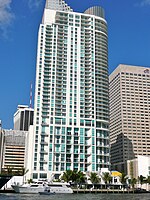Carbonell Condominium
2005 establishments in FloridaBuildings and structures completed in 2005Miami building and structure stubsResidential condominiums in the United StatesResidential skyscrapers in Miami

Carbonell Condominium is a residential high-rise building located in the Brickell neighborhood of Miami, Florida. The tower is one of the tallest buildings located on Brickell Key, a small island located due east of Brickell at the mouth of the Miami River in Biscayne Bay. Standing at 410 feet (125 metres), the building is currently tied with Two Tequesta Point as the 88th-tallest building in the city. The building's address is 901 Brickell Key Boulevard. Carbonell Condominium houses 40 floors, and was completed in 2005.
Excerpt from the Wikipedia article Carbonell Condominium (License: CC BY-SA 3.0, Authors, Images).Carbonell Condominium
Brickell Key Drive, Miami
Geographical coordinates (GPS) Address External links Nearby Places Show on map
Geographical coordinates (GPS)
| Latitude | Longitude |
|---|---|
| N 25.76925 ° | E -80.18695 ° |
Address
Carbonell Condominium
Brickell Key Drive 681
33131 Miami
Florida, United States
Open on Google Maps









